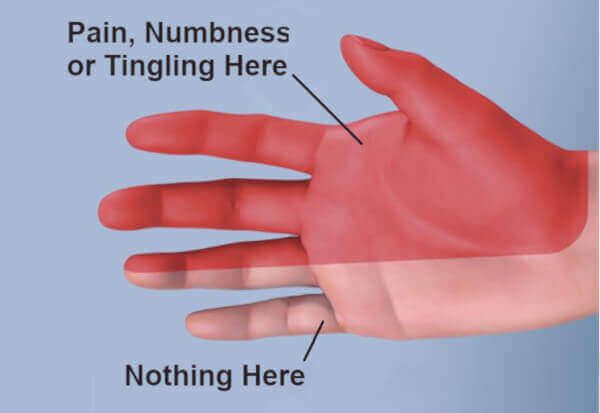Having Carpal Tunnel & Losing Grip Strength
From Dr. Z - Carpal tunnel syndrome specialist
Having Carpal Tunnel & Losing Grip Strength
When most people get carpal tunnel, losing grip strength is usually a major complaint. Unfortunately, these two problems are closely tied.
In fact, loss of hand and grip strength is one of the main symptoms of this condition. The other primary symptoms are pain, numbness, tingling, soreness, burning, and shooting electric shocks in your fingers and hand.
Having
most
of these sensations as well as losing grip strength at the same time is very common. It's especially more common as the disorder advances without treatment. Here’s what else you need to know about carpal tunnel & losing grip strength.
- FIND OUT: do you have carpal tunnel? No strings attached self-test.
Carpal tunnel, losing grip strength & other symptoms
Carpal tunnel syndrome is a painful and progressive compressive neuropathy. It happens when the median nerve (inside the wrist joint) is crushed by swollen flexor tendons.
Usually, carpal tunnel syndrome begins almost without notice. It almost always first appears at night, when you're trying to sleep. As it advances, symptoms begin to appear during the day. You might feel some numbness or tingling at your fingertips, like when holding your hand up to talk on a phone. In a short while, symptoms advance further and become more intense.
Carpal tunnel syndrome advances in 4 general stages. These are:
- Mild stage
- Moderate stage
- Severe stage
- End stage
The stages (and symptoms) of carpal tunnel’s progression vary from person to person. For example, some people advance from the mild and moderate stages to the severe stage in just a couple of months. But others can take several years. However, this neurological condition is progressive and usually worsens without intervention.
While the time course for each stage of carpal tunnel syndrome can vary, the disorder typically follows a progressive pattern.
Symptoms gradually become much more intense. As carpal tunnel advances to the severe and end stages, your life is impacted enormously and daily living becomes miserable.
What MILD carpal tunnel is like
Almost always, carpal tunnel syndrome begins imperceptibly. Most patients feel symptoms only at night, when trying to sleep. In fact, one of the hallmark carpal tunnel symptoms is that you have to wake up and shake out the numbness in your hand, or rub out the pain as you pace around the house.
Pain, numbness or tingling concentrate in the hand and fingers. Usually, it’s more pronounced in the palm, thumb, index and middle fingers. Sometimes fingers feel puffy even though they’re not. But the little finger doesn’t show signs whatsoever.
These sensations can also occur in both hands at the same time (called bilateral carpal tunnel syndrome). About 80% of the time, the dominant hand starts to show signs first. Then symptoms follow on the other hand within 6 months.
Some people describe the pain as achy, burning, sore, throbbing, or stabbing. The numbness and tingling are described as pins-and-needles, itching or scratching.
Losing grip strength usually doesn't occur in the mild stage. But with the progression of carpal tunnel, losing grip strength is almost a guarantee.
Unfortunately, most people do nothing about their mild symptoms. Perhaps they don't recognize the signs of an impending problem.
Usually it takes symptoms to worsen, accompanied with a loss of hand strength, to motivate patients to seek help. And by this time, their job is usually greatly impacted. Actually, the CDC says that weakened hands are the main reason workers need to change their jobs (or quit entirely) when they have carpal tunnel syndrome.
What MODERATE carpal tunnel is like
Without treatment, carpal tunnel syndrome usually progresses further. Numbness or tingling also become present most of the day - and without relief. You even have symptoms when your hand is resting.
At this point most people realize they have a big problem. Many begin to brace (splint) their hand at night. Unfortunately, most people use the completely wrong kind of carpal tunnel wrist brace.
Other people brace their hand while working. This is a mistake, and can even worsen symptoms.
As carpal tunnel progresses even further, the person usually feels significant pain or numbness. Typically, the pain occurs in the fingers or palm. However, it can be anywhere from the fingertips to the forearm. The pain also can be constant or intermittent, sharp or dull.
Numbness is almost constant because the condition is well-developed in the moderate stage. Hanging your hand off the bed at night doesn't help anymore. Ice baths also are ineffective. Sometimes NSAID pain relievers (Advil, Tylenol) can help ease the pain, but it's temporary.
In most patients with carpal tunnel, losing grip strength is almost guaranteed at this point. When grasping objects like a jar, electric shocks usually shoot through your hand. You begin to drop things, like a drinking lass, a cooking pan, or even a child. Finger dexterity becomes noticeably less than normal. You notice it when it feels clumsy or awkward to manipulate small objects. For instance, it’s difficult to pick up coins or keys, button a shirt or tie a shoelace.
What SEVERE carpal tunnel is like
The severe stage of carpal tunnel syndrome is characterized by intense pain, numbness or tingling that's present all day and night. There's simply no relief from it. Over-the-counter pain medicines don't help at all anymore.
In addition, patients may lose some or all temperature sensitivity in their fingers. That means it's difficult to tell if water is hot or cold. In fact, it's not uncommon for patients to injure themselves in the kitchen because they cannot feel skin burning at the fingertips.
Ironically, in the severe stage of carpal tunnel, losing grip strength is usually the least of your problems compared to the other intense symptoms. The cruel, punishing pain and crushing numbness interfere with every aspect of your life. The misery is a never-ending staircase of pain or numbness.
It's in this severe stage of carpal tunnel syndrome that symptoms are so intense that patients often say:
"I feel like cutting my hand off!"
At the end of the severe stage, muscle wasting begins. This means the normally plump muscle at the base of your thumb begins to flatten out. It means the nerve to the thumb muscle is dying. Another sign that this is happening is when it's difficult to touch your thumb to your pinky finger.
End-STAGE carpal tunnel syndrome
The final stage of carpal tunnel syndrome is the “end-stage”. Usually, the most noticeable feature is significant wasting in the muscles at the thumb's base. The muscle has degenerated and looks flat and wrinkly. There's almost no thumb function or feeling left over. This also means your grip strength is extremely compromised.
Additionally, there usually is a loss of temperature sensation. Loss of temperature sensitivity is almost complete and there's no telling hot from cold at your fingertips. Extreme care must be taken around a stove.
Ironically, as end stage progresses even further,
pain subsides in most cases. This isn't a good thing. It means the median nerve is essentially dead. The nerve transmits little or no signals (or "feelings"). But in a cruel way, numbness persists.
On the whole, carpal tunnel syndrome is progressive. The ultimate devastation of the hand demonstrates why you must treat the condition seriously and as soon as you can - at the first sign of symptoms.
Summary
When you have carpal tunnel, losing grip strength is almost inevitable unless you intervene early. By the time grip strength is noticeably compromised, you likely also have moderate pain, numbness or tingling in your hand or fingers. Therefore, pay close attention to these symptoms early on. By doing so, you can effectively treat your carpal tunnel so it doesn’t worsen.







